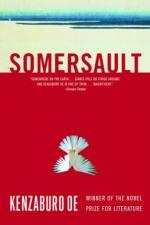|
This section contains 10,838 words (approx. 37 pages at 300 words per page) |

|
SOURCE: "Ōe's Obsessive Metaphor, Mori, the Idiot Son: Toward the Imagination of Satire, Regeneration, and Grotesque Realism," in The Journal of Japanese Studies, Vol. 7, No. 1, Winter, 1981, pp. 23-52.
[Wilson is a critic and educator specializing in Japanese and comparative literature. In the following essay, she analyzes Ōe's variations on his most recurrent themes in five of his works and elucidates its relation to the genres of satire and "grotesque realism" as defined by structuralist theory.]
Ōe Kenzaburo (1935–) is regarded in Japan and the United States as a leading postwar novelist. Deeply involved in contemporary issues, he makes a clean break from the literary traditions that nurtured such writers as the Nobel Prize winner Kawabata Yasunari (1899–1972), Shiga Naoya (1883–1972), and Mishima Yukio (1925–1970).
What is most innovative about Ōe's works is that he cultivates the techniques of Cervantes and Rabelais and follows in their footsteps. From 1964 on, by employing farce, travesty...
|
This section contains 10,838 words (approx. 37 pages at 300 words per page) |

|


